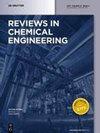化学去除间甲酚:综述
IF 4.9
3区 工程技术
Q1 ENGINEERING, CHEMICAL
引用次数: 4
摘要
摘要间甲酚废水由于其难降解性和对植物、动物和人类的高毒性,已成为一个全球性的环境问题。间甲酚相关行业的发展增加了间甲酚过量排放的风险,使高效处理间甲酚成为经济和环境方面的紧迫课题。综述了间甲酚废水的化学处理方法,包括化学吸附法、光催化降解法、电催化降解法和催化湿式氧化法。详细讨论了不同方法的效率、成本和工艺优化。化学吸附很方便,但效率相对较低。光催化降解是一种操作简单、效率高的技术,但催化剂的选择过于有限,光源成本相对较高。电催化降解虽然省时但耗能高,操作难度大给工业化带来了障碍。催化湿式氧化(CWO)是一种高效、易改性的催化剂,但催化剂的性能和稳定性仍然很中等。然后,针对实际环境的要求,分析了不同方法的选择和应用。最后,展望了高效间甲酚去除方法的发展机遇。本文章由计算机程序翻译,如有差异,请以英文原文为准。
Chemical removal of m-cresol: a critical review
Abstract m-Cresol containing wastewater has generally become a globally environmental issue due to its refractory and high toxicity towards plants, animals and human being. The development of m-cresol related industries increases the risk of excessive m-cresol discharge, making high efficiency methods to treat m-cresol an urgent topic in both economic and environmental aspects. This review focuses on the chemical treatment methods of m-cresol wastewater, including chemical adsorption, photocatalytic degradation, electrocatalytic degradation and catalytic wet oxidation. The efficiency, cost and process optimization of different methods are discussed in detail. Chemical adsorption is convenient but has relatively low efficiency. Photocatalytic degradation is an easily operated technology with high efficiency, but the selection of catalyst is too limited and the cost of light source is relatively high. Electrocatalytic degradation is time-saving but energy-intensive, and operational difficulty brings a barrier to industrialization. Catalytic wet oxidation (CWO) is highly effective and easily modified, but the performance and stability of catalysts are still very moderate. Following this, the selection and application of different methods regarding the requirement of actual environment are analyzed. Finally, a perspective on the opportunities and development for efficient m-cresol removal method is given.
求助全文
通过发布文献求助,成功后即可免费获取论文全文。
去求助
来源期刊

Reviews in Chemical Engineering
工程技术-工程:化工
CiteScore
12.30
自引率
0.00%
发文量
37
审稿时长
6 months
期刊介绍:
Reviews in Chemical Engineering publishes authoritative review articles on all aspects of the broad field of chemical engineering and applied chemistry. Its aim is to develop new insights and understanding and to promote interest and research activity in chemical engineering, as well as the application of new developments in these areas. The bimonthly journal publishes peer-reviewed articles by leading chemical engineers, applied scientists and mathematicians. The broad interest today in solutions through chemistry to some of the world’s most challenging problems ensures that Reviews in Chemical Engineering will play a significant role in the growth of the field as a whole.
 求助内容:
求助内容: 应助结果提醒方式:
应助结果提醒方式:


